
Video Upload Options
A V-twin engine, also called a V2 engine, is a two-cylinder piston engine where the cylinders share a common crankshaft and are arranged in a V configuration. Although widely associated with motorcycles (installed either transversely or longitudinally), V-twin engines have also been used for industrial engines and in several small cars. The V-twin design dates back to the late 1880s.
1. Origins
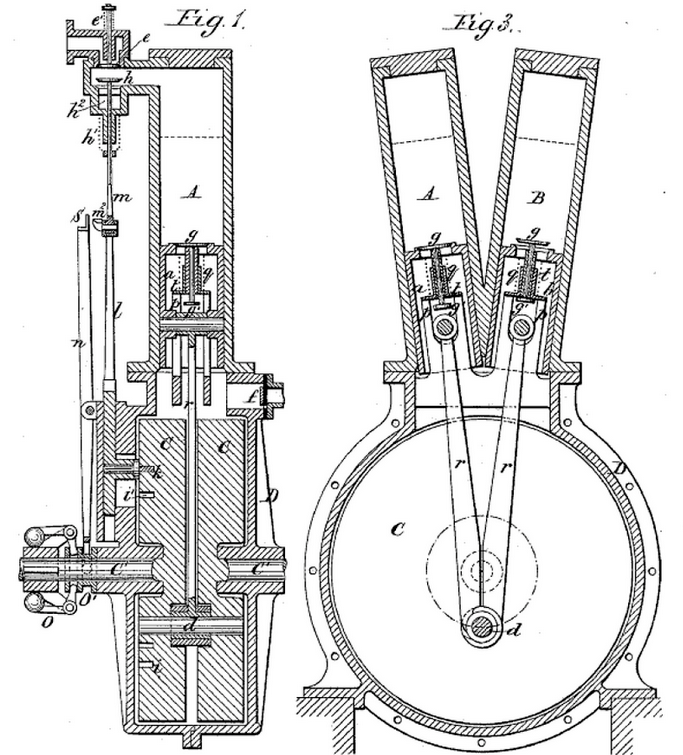
1889 Daimler V-twin engine. https://handwiki.org/wiki/index.php?curid=1740169
One of the first V-twin engines was built by Gottlieb Daimler in 1889. It was used as a stationary engine, for boats and in the Daimler Stahlradwagen ("steel-wheeled car"), Daimler's second car.[1] The engine was also manufactured under licence in France by Panhard et Levassor.[2]
An early V-twin engined motorcycle was produced in November 1902 by the Princeps AutoCar Company in the United Kingdom.[3] The following year, V-twin motorcycles were produced by Eclipse Motor & Cycle Co in the United Kingdom (the XL-ALL model),[4], Glenn Curtiss in the United States, and NSU Motorenwerke in Germany.[5]
Peugeot, which had used Panhard-built Daimler V-twins in its first cars,[2][6] began producing its own V-twin engines in the early 20th century. This Peugoet engine powered a Norton motorcycle that won the first Isle of Man TT race in 1907.[6]
2. Typical Design
2.1. Crankshaft Configuration
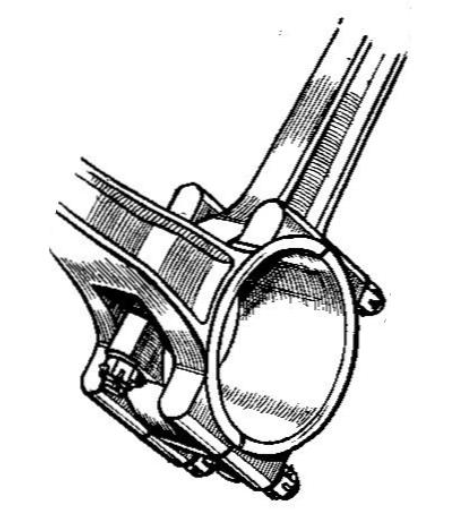
"Fork & blade" connecting rods. https://handwiki.org/wiki/index.php?curid=1608533
Most V-twin engines have a single crankpin, which is shared by both connecting rods. The connecting rods may sit side-by-side with offset cylinders, or have fork and blade connecting rods which avoids the twisting forces caused by having offset cylinders.
Some notable exceptions include a 180° crank pin offset used by the 1935 Moto Guzzi 500cc,[7] a dual-crankpin configuration used by the 1983 Honda Shadow 750,[8] and the 75° crank pin offset (45° offset in the United States) used by the 1987 Suzuki VX 800.[9]
2.2. V Angle
Although any 'V angle' (the angle between the two banks of cylinders) between zero and 180 degrees is theoretically possible for a V-twin engine, in practice angles smaller than 40 degrees are rarely used for practicality reasons. The most common V angle for a V-twin engine is 90 degrees, which can achieve a perfect primary balance (if the correct counterweight is used) like most Ducatis, most Moto Guzzis, the Honda RC51, Suzuki TL1000s and TL1000R.[10][11] However, this arrangement results in an uneven firing order, with the second cylinder firing 270 degrees after the first cylinder, then a 450 degrees interval until the first cylinder fires again. 90 degree engines are sometimes called L-twin (like the "L" in TL1000R or TL1000S) rather than V-twin.
When a V angle of less than 90 degrees is used, perfect primary balance can only be achieved if offset crankpins are used. If not, balance shafts are usually required to reduce the vibration.[10] Vehicles which use engines with V angles of less than 90 degrees include:
- 20 degrees: 1889 Daimler Steel-wheel car[1]
- 42 degrees: 1916-1923 Indian Powerplus, 1920-1949 Indian Scout, 1922-1953 Indian Chief
- 45 degrees: 1909-present Harley-Davidson V-twin, 1990-1997 Suzuki VX 800, 2001-present Suzuki Boulevard C50, 1985-2007 Honda VT1100
- 48 degrees: 2005-2012 Yamaha MT-01, 1999-present Yamaha XV1600A
- 50 degrees: 1919-1924 BSA Model E, 1924-1936 Brough Superior SS100, 1929-1940 Matchless Model X, 1936-1955 Vincent Rapide, all Victory Freedom engines
- 52 degrees: 1997-present Honda Shadow, 1987-present Honda Transalp, 1998-2013 Honda Deauville, 2004-2010 Kawasaki Vulcan 2000 series
- 54 degrees: 2008-present Suzuki Boulevard C109R, 2006-present Suzuki Boulevard M109R
- 55 degrees: 1985-2006 Kawasaki Vulcan 750, 2006-present Kawasaki Vulcan 900 Classic
- 60 degrees: 2001-2017 Harley-Davidson VRSC, 1998-2003 Aprilia RSV Mille, 1988-present Yamaha XV250, 2001-present Yamaha DragStar 250, 2015-present Indian Scout (motorcycle)
- 70 degrees: 1988-1998 Suzuki RGV250, 1987-2004 Yamaha Virago 535, 1997-present Yamaha DragStar 650
- 72 degrees: 1974-1989 Moto Morini 350 & 500 V-twins
- 75 degrees: 2005-present Hyosung GT250, 2008-2015 KTM 1190 RC8, 1981-2007 Yamaha Virago, 1998-2008 Yamaha DragStar 1100
- 80 degrees: 1978-1983 Honda CX series, Rotax 810/660/490 engines
Vehicles which use engines with V angles of greater than 90 degrees include the 1934 Moto Guzzi 500cc (120 degrees) and the 1940-1948 Zündapp KS 750 (170 degrees).[12]
3. Motorcycles
As per other motor vehicles, the terms longitudinal engine and transverse engine are most often used to refer to the crankshaft orientation relative to the frame.[13][14] However, some companies use the opposite terminology, stating that a "transverse" V-twin engine has the cylinders mounted on each side of the motorcycle (therefore with the crankshaft running in line with the frame) and that a "longitudinal" V-twin engine has the cylinders at the front and rear.[15] The latter terminology is used by the Italian manufacturer Moto Guzzi.[16]
To avoid such ambiguity, some people use descriptions of "transverse crankshaft engine", "longitudinal crankshaft engine",[13][17] or "transversely mounted cylinders".[18]
3.1. Transverse Engine
The most common arrangement is to mount the engine with the crankshaft oriented transversely to the frame. The advantage of this mounting is that the width of the motorcycle can be smaller than a longitudinally-mounted V-twin.[19] A disadvantage of this configuration for air-cooled engines is that the two cylinders receive different air-flows and cooling of the rear cylinder tends to be restricted[20] (although the uneven cooling isn't as pronounced as a parallel-twin engine, where the inner faces of the cylinders are not exposed to any airflow). Some transverse V-twins use a single carburettor in the middle of the V-angle to feed both cylinders. While this avoids the need for two carburettors, it creates further cooling problems for the rear cylinder by placing its hot exhaust port and pipe at the back of the cylinder, where it may be exposed to less cooling airflow.
Transverse V-twin engines have been used by Harley-Davidson, Ducati and many recent Japanese motorcycles, such as the Suzuki SV650. Some Ducati V-twin engines have been marketed as "L-twin" engines, due to the front cylinder being vertical and the rear cylinder being horizontal, thus forming an "L" shape.
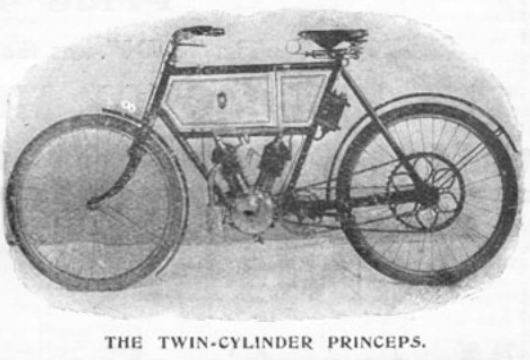
1902 Princeps V-Twin (air-cooled). https://handwiki.org/wiki/index.php?curid=1099804

1933-1939 Sokół 1000 (air-cooled). https://handwiki.org/wiki/index.php?curid=1388115
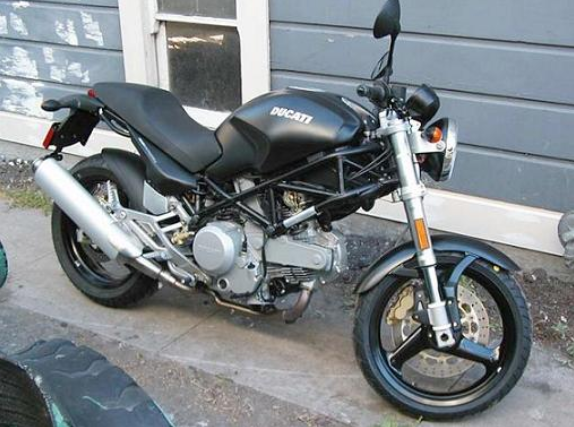
2002 Ducati Monster 620 (air-cooled). https://handwiki.org/wiki/index.php?curid=1355063
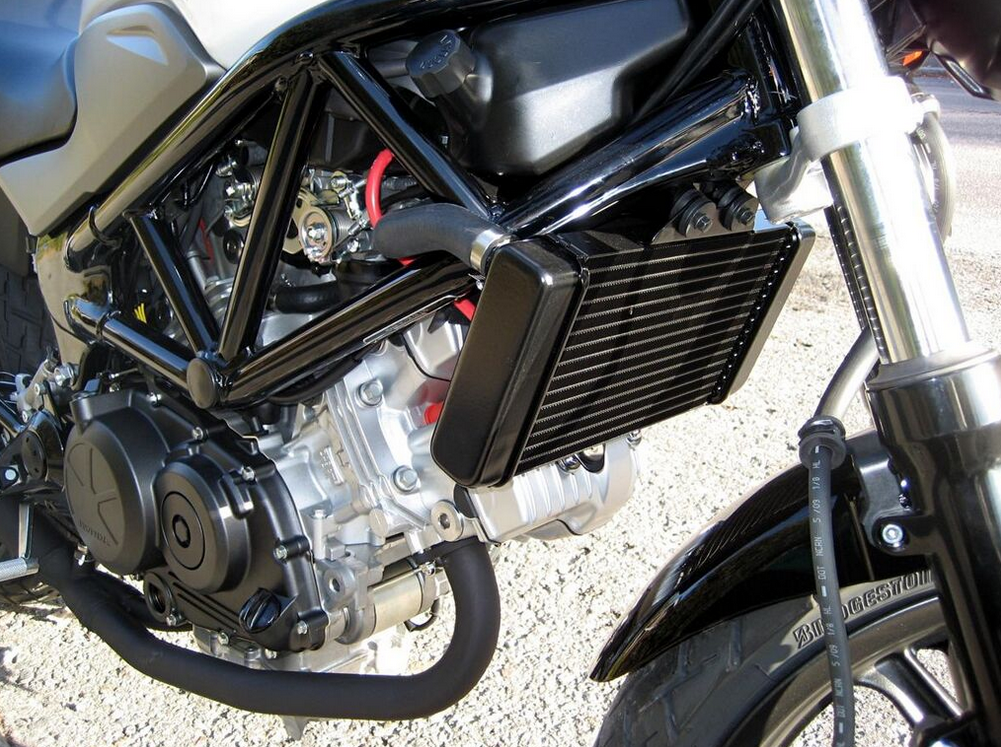
2009 Honda VTR250 (water-cooled). https://handwiki.org/wiki/index.php?curid=1355063
3.2. Longitudinal Engine
A less common arrangement is to mount the engine longitudinally. An advantage of this arrangement is that both cylinder heads can protrude into the air stream, so they can each receive the same amount of cooling (for air-cooled engines).[21] Also, the transmission being located behind the engine is easier to fit within a typical motorcycle frame and, for shaft-drive motorcycles, a 90° bevel gear is not needed at the start of the driveshaft.
As per all longitudinal engines, a disadvantage is that the torque reaction will twist the motorcycle to one side (such as on sharp acceleration/deceleration or when opening the throttle in neutral) instead of shifting the weight balance between the front and rear wheels. However, many modern motorcycles reduce this effect by rotating flywheels or alternators in the opposite direction to that of the crankshaft.[22][23]
Longitudinal V-twin engines have been used by the Honda CX series and several Moto Guzzi motorcycles.

1978-1983 Honda GL500 Silver wing 80° V-twin. https://handwiki.org/wiki/index.php?curid=1126590

2000 Moto Guzzi Jackal 90° V-twin. https://handwiki.org/wiki/index.php?curid=1098391
4. Automobiles
Most cars are powered by engines with three or more cylinders, however several small cars have been produced with V-twin engines.
From 1911-1939, various Morgan F-series three-wheeled cyclecar models were powered by V-twin engines. Production of three-wheeler models then resumed with the 2012-present Morgan 3-Wheeler. Also in the United Kingdom, Birmingham Small Arms Company (BSA) produced several cars powered by their V-twin motorcycle engines. These were produced from 1921-1926 (four-wheel models) and 1929-1936 (three-wheel and four-wheel models).[24]
Several manufacturers have produced models inspired by the original Morgan three-wheeled car, such as the 1978-present Triking Cyclecar (using a Moto Guzzi engine),[25] the 2006-present Ace Cycle Car (using a Harley-Davidson engine)[26] and the 1990-present JZR Trikes kit car (using engines from several manufacturers).[27]
Mazda's first car, the 1960-1966 Mazda R360 rear-engined kei car, was powered by the 356 cc (21.7 cu in) Mazda V-twin engine.[28][29] The 1961-1962 Mazda B360 front-engined light commercial vehicle used a 577 cc (35.2 cu in) version of this engine.

1934 Morgan Super Sports (using a JAP engine). https://handwiki.org/wiki/index.php?curid=1787485
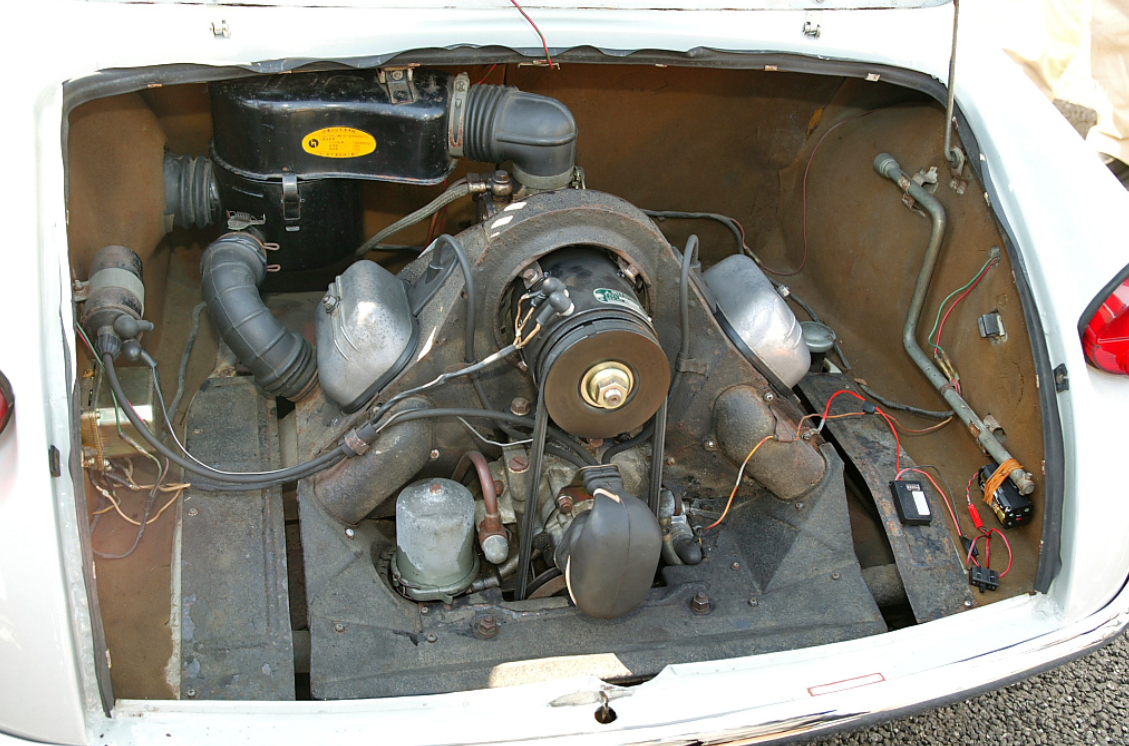
1960-1966 Mazda R360 engine. https://handwiki.org/wiki/index.php?curid=1986228
5. Industrial Engines

A Briggs & Stratton 90° industrial engine (seen from the accessory end). https://handwiki.org/wiki/index.php?curid=1593146
Various V-twin engines have been produced for industrial uses such as pressure washers, lawn and garden tractors, tillers, generators and water pumps. The engines are usually air-cooled with a 90° V angle. Depending on the application, the engine's orientation can be either have a horizontal or vertical crankshaft.
Manufacturers of commercial V-twin engines include Briggs & Stratton with its Vanguard, Professional and Intek V-twin series,[30] Honda with its V-twin series engines,[31] Kawasaki with its FD, FH, FS, and FX series,[32] Subaru with its EH series,[33] Tecumseh with its OV691EA and TVT691 engines,[34] and Kohler.[35]
References
- Posthumus, Cyril (1977) [1977]. "Fathers of Invention". The story of Veteran & Vintage Cars. John Wood, illustrator (Phoebus 1977 ed.). London: Hamlyn / Phoebus. pp. 12–13. ISBN 0-600-39155-8. https://archive.org/details/storyofveteranvi0000unse. "But the engine, now fitted lower, in front of the rear axle, had progressed to become a narrow vee-twin with cylinders at 20°, and giving an estimated 1.6hp at 700 rpm."
- Ling, Peter J. (1990). America and the Automobile: Technology, Reform and Social Change, 1893-1923. Manchester, UK: Manchester University Press. p. 97. ISBN 0-7190-3808-1. https://books.google.com/?id=LQDoAAAAIAAJ. Retrieved 2013-01-18.
- "Motor Cycling, November 12th, 1902". Archived from the original on 5 April 2016. https://web.archive.org/web/20160405193810/http://www.oldbike.eu/museum/wp-content/uploads/2011/10/1902_Motorcycling_30-copy1.jpg. Retrieved 9 May 2018.
- "The Evolution of the Motor Cycle", Motor Cycle magazine, June 1st, 1922, pp700-706
- de Cet, Mirco, ed (2002). The Illustrated Directory of Motorcycles. St. Paul, MN USA: Salamander Books. pp. 117, 340. ISBN 0-7603-1417-9. https://books.google.com/?id=wNzyIcw2vxoC. Retrieved 2013-01-18.
- Walker, Mick (2000). Mick Walker's European Racing Motorcycles. Tyne & Wear, UK: Redline Books. p. 92. ISBN 0-9531311-3-0. https://books.google.com/?id=7bGuud7_uy0C. Retrieved 2013-01-18.
- Garson, Paul (2005-03-20). "I Coulda Had a V-8.... so I Did". Motorcycle.com. Verticalscope. Archived from the original on 2008-08-21. https://web.archive.org/web/20080821151644/http://www.motorcycle.com/events/i-coulda-had-a-v8-so-i-did-12730.html. Retrieved 2010-04-18. "By 1934 Guzzi offered a range of 175, 250 and 500cc models including full touring machines. The next year they raised the ante once again, challenging the all-vanquishing Norton at the legendary Isle of Man TT, basically a course the British racer owned lock, stock and single barrel thanks to a phenomenal rider, Scotsman Jim Guthrie. Moto Guzzi went to a Brit for riding skills, one Stanley Woods. They gave him a new racer featuring a 120-degree V-twin with offset cranks firing at 180 degrees with bevel gears and shafts driving the SOHC, good enough for 44 hp at 7500 rpm and 112 mph, on equal standing with the Norton. It had an ace up its sleeve so to speak in that it incorporated a type of pivoted-fork rear suspension while the frontend was a springer, a design that had never won a Senior TT due to its handling deficiencies, or so was thought. Guzzi had done some tweaking in that department as well. It also came equipped with a massive twin-leading shoe front brake, a 4-speed gearbox, and alloy wheels, another innovation to cut down unsprung weight. When the dust had settled and the calculations determined, the wreath of victory went to Woods and Moto Guzzi, leaving Norton as they say, gobsmacked. Not only that, the Guzzi had smashed the track lap record. The next day Moto Guzzi was world famous."
- "Honda: 1983 Shadow 750". Archived from the original on May 19, 2008. https://web.archive.org/web/20080519233200/http://powersports.honda.com/the_story/heritage/heritage_milestone.asp?Decade=1980&TargetUrl=Milestone%2FMilestone_Model_0102.asp&PrevPageTitle=TimeLine. Retrieved 2008-05-20.
- "Suzuki VX800". Cycle World: 36–37. July 1990. "At some point in the motorcycle's development, the company changed the crankpin offset from 45 to 75 degrees in hope of creating a smoother-running motor. But just as production began, American Suzuki engineers decided that the new offset resulted is less mid-range power as well as a too-sanitized exhaust note, one that didn't sound very V-Twin-like. Presto, now the US models come with the 45-degree offset, while the rest of the world gets the 75-degree staggered crankpins.".
- Vittore Cossalter. "Shaking forces of twin engines". Archived from the original on 2011-07-24. https://web.archive.org/web/20110724060837/http://www.sense.net/~blaine/twin/twin.html. Retrieved 2010-07-25.
- "The Physics of: Engine Cylinder-Bank Angles". 14 January 2011. https://www.caranddriver.com/features/a15126436/the-physics-of-engine-cylinder-bank-angles-feature/. Retrieved 18 August 2019.
- Gantriis, Peter; Von Wartenberg, Henry (2008). The Art of BMW: 85 Years of Motorcycling Excellence. MotorBooks International. p. 80. ISBN 978-0-76033-315-0. "The Zundapp (sic) was powered by an air-cooled 170-degree V-twin that was very similar in design that was very similar in design to the BMW boxer twins"
- Cossalter, Vittore (2006). Motorcycle Dynamics (Second ed.). Lulu.com. pp. 291–294. ISBN 978-1-4303-0861-4.
- Foale, Vittore (2006). Motorcycle Handling and Chassis Design: the art and science (Second ed.). Tony Foale. pp. 11–6. ISBN 978-84-933286-3-4. https://archive.org/details/motorcyclehandli00foal.
- Coombs, Matthew; Haynes, John; Shoemark, Pete (2002). Motorcycle Basics (2nd ed.). Haynes. p. 1•31. ISBN 978-1-85960-515-8. https://books.google.com/books?id=D0DhHAAACAAJ. "The transversely mounted [cylinder] V-twin, as used to good effect for many years by Moto Guzzi, slots easily into the frame, and has excellent cooling as both heads are stuck out into the wind. It also provides the perfect set-up for using shaft drive." Holmstrom, Darwin (2001). The Complete Idiot's Guide to Motorcycles. Alpha Books. ISBN 978-0-02-864258-1. https://books.google.com/books?id=VGrp5Pjsf4UC&pg=PA82. "Ducati's engines, which are longitudinal (they are positioned lengthwise in the frame) most obviously display the "L" configuration, but Moto Guzzi's engines, which are transverse (arranged croswise in the frame), are also at 90 degrees." New 2009 Moto Guzzi V7 Classic Honors Historic Roots, Moto Guzzi Spa, archived from the original on May 27, 2009, https://web.archive.org/web/20090528073549/http://www.motoguzzi-us.com/servonline/news/dettaglio.asp?indice=271, retrieved 2009-04-29, "Just as importantly, the V7 became an instant technology trendsetter thanks to its innovative transverse, air-cooled V-twin engine with shaft drive." Out of history, on to the road., Moto Guzzi Spa, archived from the original on March 26, 2009, https://web.archive.org/web/20090326002937/http://www.motoguzzi-us.com/Nuovi_modelli/breva1100/specifiche4.asp?pagina=spec&modello=breva1100&pag=4, retrieved 2009-04-29, "We could, of course write a book about Moto Guzzi’s transverse V-Twin." Grubb, Jake (March 1975). Easy Riders Grand Touring Motorcycles for '75. 143. Hearst Magazines. 82. https://books.google.com/books?id=aeMDAAAAMBAJ&pg=PA82. Retrieved 2009-04-29. "Ducati 750 Sport with its clip-on handlebars and racing setup, is for those who want to do their touring stretched out prone! Engine is a longitudinal V-twin. ..The unique 90∘longitudinal engine produces enormous low and mid-range torque...Moto Guzzi 850T...An 850-cc 90° transverse V-twin engine..."
- Carpenter, Susan (2007-07-25), "Chaps aren't de rigueur, but a helmet, yes", ASK THROTTLE JOCKEY, archived from the original on 2013-12-21, https://web.archive.org/web/20131221081941/http://www.latimes.com/classified/automotive/highway1/la-hyw-qa25jul25,1,2706840.story, "According to my source at Moto Guzzi Technical Services, "The Guzzi engine is a 90-degree 'L' twin, actually, because the cylinders are oriented at 90 degrees, instead of a typical V twin that has a smaller angle ( 60-degree, 77-degree, etc.). It is called 'transverse' because the engine is mounted with the crankshaft oriented front to back instead of left to right. Because of this you cannot run a chain or belt drive directly to the rear wheel like in most motorcycles. This is why you have a separate gearbox that bolts to the engine and transfers the power to the rear wheel via the drive shaft. This is how it is done on the Moto Guzzi and a BMW."
- Cocco, Gaetano (2004), Motorcycle design and technology, MotorBooks/MBI Publishing Company, pp. 117 ff, ISBN 978-0-7603-1990-1
- Heritage/History: Design/Technology, BMW Motorrad, archived from the original on September 27, 2007, https://web.archive.org/web/20070927231254/http://www.bmwmotorcycles.com/pdfs/history/design_tech.pdf, "...the boxer had three unique innovations that would remain throughout its years in development:The engine design included transversely mounted cylinders, which were cooled by exposure to the passing air."
- Cocco, Gaetano (2004). "Chapter 11 The Engine". Motorcycle Design and Technology. St. Paul, MN USA: MotorBooks International. p. 117. ISBN 0-7603-1990-1. https://books.google.com.jm/books?id=Ydk0bgq2_3YC&pg=PA113&source=gbs_toc_r&cad=4#v=onepage&q&f=false. Retrieved 2013-05-28. "In some construction layouts the transverse width is the same as a single-cylinder engine, which allows very narrow frames and bodywork with small frontal areas."
- Dean, Paul (May 2005). Edwards, David. ed. "Service: Oil miser". Cycle World (Newport Beach, CA USA: Hachette Filipacchi Media) 44 (5): 160. ISSN 0011-4286. Archived from the original on 2014-04-15. https://web.archive.org/web/20140415094643/http://books.google.com.jm/books?id=E86bEyC7DzoC&pg=RA5-PA60&dq=V-twin+%22rear+cylinder%22+cooling&hl=en&sa=X&ei=GlKiUY6UN43S9gSkoYCgBg&ved=0CCoQ6AEwADgo#v=onepage&q=V-twin%20%22rear%20cylinder%22%20cooling&f=false. Retrieved 2013-05-26. "An air-cooled big-bore V-twin in particular can get very hot, especially the rear cylinder, which is not exposed to as much cooling air as the front.".
- Coombs, Matthew; Haynes, John; Shoemark, Pete (2002), Motorcycle Basics (2nd ed.), Haynes, p. 1•31, ISBN 978-1-85960-515-8, https://books.google.com/books?id=D0DhHAAACAAJ
- Friedman, Art; Trevitt, Andrew; Cherney, Andrew; Elvidge, Jamie; Brasfield, Evans (April 2000). "Sport Cruisers Comparison - Seven Sport-Cruiser Motorcycles". Motorcycle Cruiser. Source Interlink Media. "Take a Spin" section, paragraph 4. Archived from the original on 2010-05-02. https://web.archive.org/web/20100502180324/http://www.motorcyclecruiser.com/roadtests/sport_cruisers_comparison/index.html. Retrieved 2010-09-10. "Though the Valkyrie also has a longitudinal crankshaft, this torque reaction has been eliminated by making some of the components, such as the alternator, spin the opposite direction of the engine."
- Battisson, Stephen (1997). "Developing the V6 - Taming The Beast". The Laverda V6. Stephen Battisson. p. 3. Archived from the original on 2011-07-08. https://web.archive.org/web/20110708092245/http://www.breganzane.com/vm/history/v6/page3.html. Retrieved 2010-09-10. "By arranging the rest of the engine internals to rotate in the opposite direction to the crankshaft their forces are cancelled out without having to resort to the weight, complexity and friction associated with two crankshafts."
- Bobbitt, Malcolm (2004). Three Wheelers - Those were the days. Veloce Publishing Ltd. p. 16. ISBN 978-1-903706-81-7.
- "Triking". 3wheelers.com. Archived from the original on 2010-10-05. https://web.archive.org/web/20101005102736/http://3wheelers.com/triking.html. Retrieved 2010-08-21.
- "Ace Cycle Car". Archived from the original on 2008-12-10. https://web.archive.org/web/20081210235648/http://cycle-car.com/. Retrieved 2008-11-27.
- "JZR Vehicles". 3wheelers.com. Archived from the original on 2010-10-05. https://web.archive.org/web/20101005101746/http://3wheelers.com/jzr.html. Retrieved 2010-09-10.
- Adolphus, David Traver. "Hemmings Motor News: 1964 Mazda R360". Hemmings Motor News. Archived from the original on 2012-07-11. https://web.archive.org/web/20120711000000/http://www.hemmings.com/hsx/stories/2007/07/01/hmn_feature20.html. Retrieved 2010-08-21.
- "1962 Mazda R-360 Coupe "De Luxe"". The Bruce Weiner Microcar Museum. Archived from the original on 2010-09-24. https://web.archive.org/web/20100924173219/http://microcarmuseum.com/tour/mazda-r360.html. Retrieved 2010-08-21.
- "Briggs & Stratton Riding Mower Engines". Archived from the original on 2011-04-26. https://web.archive.org/web/20110426130422/http://www.briggsandstratton.com/engines/riding-mower/. Retrieved 2011-04-21.
- "Honda V-TWIN SERIES ENGINES". Archived from the original on 2011-07-22. https://web.archive.org/web/20110722090313/http://engines.honda.com/models/series/v-twin. Retrieved 2011-04-21.
- "Kawasaki ENGINE SERIES". Archived from the original on 2011-04-23. https://web.archive.org/web/20110423090518/http://www.kawpowr.com/engines/type.aspx?shaft=0. Retrieved 2011-04-21.
- "Subaru Robin". Archived from the original on 2010-11-29. https://web.archive.org/web/20101129050447/http://robinamerica.com/engines.aspx. Retrieved 2011-04-21.
- "Tecumseh Power". Archived from the original on 2011-07-16. https://web.archive.org/web/20110716202231/http://www.tecumsehpower.com/CustomerService/ServiceEnginesandAccessories.pdf. Retrieved 2011-04-21.
- "Kohler Engines". Archived from the original on 2011-04-24. https://web.archive.org/web/20110424113014/http://www.kohlerengines.com/onlinecatalog/productMatrix.htm. Retrieved 2011-04-21.




